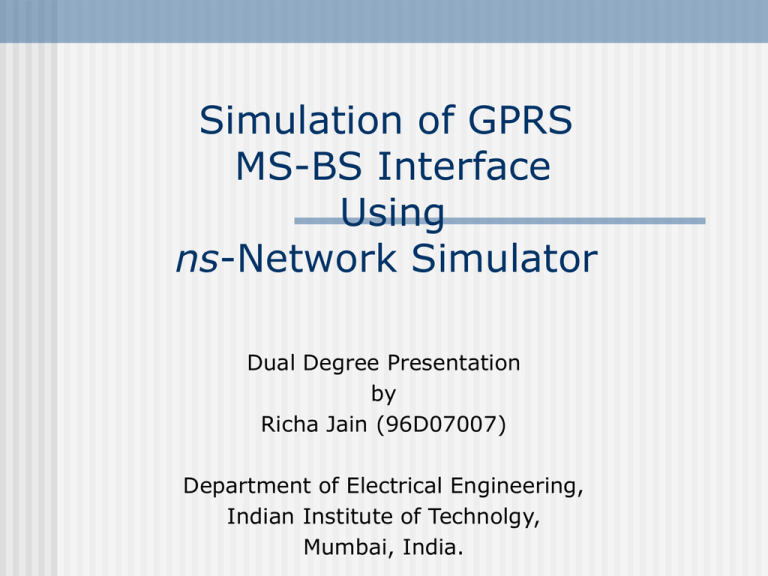Simulation of GPRS MS-BS Interface Using ns
advertisement

Simulation of GPRS MS-BS Interface Using ns-Network Simulator Dual Degree Presentation by Richa Jain (96D07007) Department of Electrical Engineering, Indian Institute of Technolgy, Mumbai, India. Outline • • • • • • Introduction to GPRS About ns-Network Simulator Scope of the Project Implementation details Experiments Concluding remarks.. The General Packet Radio Service • • • • • Packet switched radio transmission Suited for bursty applications (eg Internet) Data rates upto 170 kbps Re-uses GSM resources Lower call set-up times; cheaper GPRS Architecture GPRS Protocol Stack About ns • • • • Public domain Event driven simulator Split language – OTcl and C++ Nodes and links; routing algorithms; queuing schemes • Protocols – TCP, UDP, IP • Traffic generators – CBR, Exponential, Pareto • Basic mobility support. A simple ns script set ns [new Simulator] #Creating two nodes set n0 [$ns node]; set n1 [$ns node] #Creating a link btwn the nodes; prop delay=10ms; Drop tail. $ns duplex-link $n0 $n1 1Mb 10ms DropTail #Nodes themselves don't send/rx data. Create an agent to do so set cbr0 [new Agent/CBR] $ns attach-agent $n0 $cbr0 #create sink set null0 [new Agent/Null] $ns attach-agent $n1 $null0 #connect the two agents $ns connect $cbr0 $null0 #Tell cbr0 when to start and stop $ns at 0.5 "$cbr0 start" $ns at 4.5 "$cbr0 stop“ $ns run Wireless Features • • • • • Mobile node (ad-hoc node) Air interface Radio propagation model Adhoc routing protocols Mobile IP Structure of a wireless node in ns Sample script for a wireless simulation # Set up hierarchical routing. # Specify topology. # Create ‘God’ # Create a Base Station $ns_ node-config -adhocRouting DSR -llType LL -macType 802.11 -ifqType DropTail -ifqLen 100 -antType OmniAntenna -propType TwoRayGround -phyType WirelessPhy -topoInstance $topo -wiredRouting ON -agentTrace ON -routerTrace ON -macTrace ON -movementTrace OFF -channel $chan_ Sample script for a wireless simulation set BS(0) [$ns_ node 1.0.0] $BS(0) random-motion 0 $BS(0) set X_ 1.0 $BS(0) set Y_ 2.0 # create mobilenodes in the same domain as BS(0) $ns_ node-config -wiredRouting OFF set node_(0) [ $ns_ node 1.0.1] $node_(0) base-station [AddrParams addr2id [$BS(0) node-addr]] #create and attach Agents – TCP/UDP/CBR : : #include movement.. $ns_at 10.0 “$node(0) setdest 200.0 150.0 15.0 : : : Scope of the project We simulate the network stack for the MS-BS interaction and focus on the handling of radio resources. GPRS Air interface • • • • • TDMA Uplink-downlink skew of 3 slots Physical channel = a slot on a frequency. Logical channels – Broadcast/Control/Data. Multiplexing logical channels onto physical channels • Transmission bursts Transmission over the air interface (in GPRS) 200bytes A radio block (RLC PDU) TDMA frames 0 1 2 3 4 5 6 7 0 1 2 3 4 5 6 7 0 1 2 3 Features of our GPRS simulator • The Set-up • A single cell • The wireless node now has LL, RLC, MAC for GPRS. • Supports traffic in either direction : MS to BS or BS to MS • BS can transmit/receive on multiple frequencies GPRS sim Air Interface / Channels • • • • Separate uplink/downlink frequencies. TDMA structure with 8 slots per frame. Uplink-downlink skew of 3 slots. User defined options: - number of frequencies - number of GPRS slots per frame • Signaling channel – slot0, on uplink/downlink frequency 0. GPRS sim Transmission and reception over the air-interface • RLC PDU size set to 50 bytes => 50 bytes transmitted per slot . • Propagation delay set to 0. • Timers model transmission and reception. • A ‘radio’ : switched ON during transmission/reception, OFF otherwise. GPRS sim Signaling for Call Set-Up and Handling • Resource Request Message • from MS to BS • on the Random Access channel (slot0, freq0) • lock IFQ • wait only one TDMA frame for reply • Resource Reply Message • from BS to MS on allotted channel • update vlr_ tables • wait till MS receives reply before transmitting GPRS sim Signaling…. • Resource Release Message • from MS to BS • on the dedicated slot • clear entries • later requests will be treated on par with fresh requests GPRS sim Resource Handling • Slot Allocation • first free slot is alloted. • allocation symmetric on uplink and downlink. • Slot Release • MS initiates message on expiry of slot_release_timer. • BS deletes vlr_ entries on receipt of message. • timer value based on experiments. GPRS sim Dealing with Exceptions • Collisions • happen only on the Random Access channel. • BS drops all colliding requests. • each MS waits one TDMA frame, then backs off for a random interval. • Slot level errors • error model introduced. • users may include/not; user defined rate. • Multiple ARP requests • secondary requests dropped. GPRS sim Experiments • Studying the average packet delay • • • Scenario Observations Inferences GPRS sim Average packet delay for various data rates GPRS sim Average packet delay for various data rates GPRS sim Average packet delay vs data generation rates GPRS sim Simulations … • Resource release timer • Scenario • Observations • Inferences • Interaction of LL/RLC and TCP’s ARQ • GPRS vs GSM capacity analysis GPRS sim Summarizing …. • A simulator for the GPRS MS-BS interface was developed. • Features of the simulator were tested. • Experiments on the average packet delay, slot release timer etc were performed.



